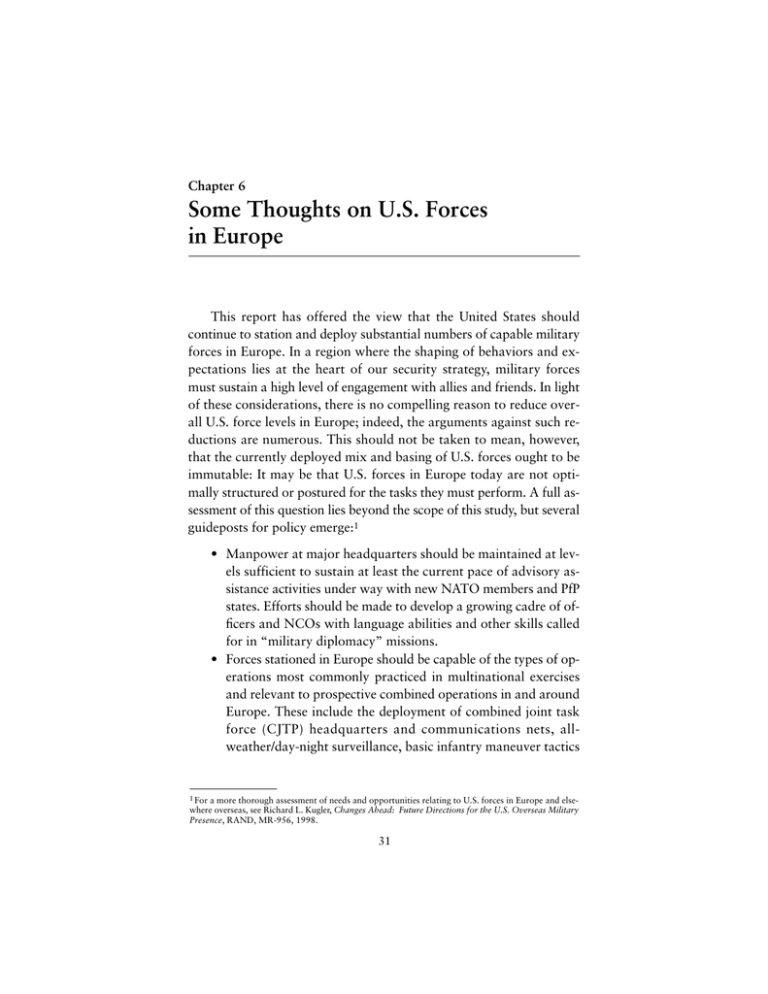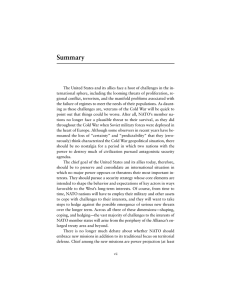Some Thoughts on U.S. Forces in Europe
advertisement

Chapter 6 Some Thoughts on U.S. Forces in Europe This report has offered the view that the United States should continue to station and deploy substantial numbers of capable military forces in Europe. In a region where the shaping of behaviors and expectations lies at the heart of our security strategy, military forces must sustain a high level of engagement with allies and friends. In light of these considerations, there is no compelling reason to reduce overall U.S. force levels in Europe; indeed, the arguments against such reductions are numerous. This should not be taken to mean, however, that the currently deployed mix and basing of U.S. forces ought to be immutable: It may be that U.S. forces in Europe today are not optimally structured or postured for the tasks they must perform. A full assessment of this question lies beyond the scope of this study, but several guideposts for policy emerge:1 • Manpower at major headquarters should be maintained at levels sufficient to sustain at least the current pace of advisory assistance activities under way with new NATO members and PfP states. Efforts should be made to develop a growing cadre of officers and NCOs with language abilities and other skills called for in “military diplomacy” missions. • Forces stationed in Europe should be capable of the types of operations most commonly practiced in multinational exercises and relevant to prospective combined operations in and around Europe. These include the deployment of combined joint task force (CJTP) headquarters and communications nets, allweather/day-night surveillance, basic infantry maneuver tactics 1 For a more thorough assessment of needs and opportunities relating to U.S. forces in Europe and elsewhere overseas, see Richard L. Kugler, Changes Ahead: Future Directions for the U.S. Overseas Military Presence, RAND, MR-956, 1998. 31 32 NATO’S FUTURE: IMPLICATIONS FOR U.S. MILITARY CAPABILITIES AND POSTURE (up to battalion level), small- and large-scale gunnery, air defense (including dissimilar air combat tactics—DACT), suppression of enemy air defenses (SEAD), ground attack, and base security. NATO forces also might begin to place increasing emphasis on military operations in urban terrain (MOUT). • U.S. forces in Europe should be capable of rapidly deploying to new operating locales and conducting high-tempo operations. Taken together, these general findings suggest that the U.S. Air Force presence in Europe is well-balanced (albeit modestly sized) and suited to its missions in peacetime and conflict. The forces consist of one squadron of ground attack aircraft (A/OA-10s), two squadrons of air superiority aircraft (F-15Cs), two squadrons of aircraft specialized for surface-to-air missile (SAM) suppression (F-16CJs), and four squadrons of multirole F-15E and F-16 aircraft.2 These combat fighters are supported by C-130 airlifters, KC-135 aerial refueling aircraft, and other support aircraft. Although these assets must generally be supplemented by reconnaissance and other specialized aircraft for the conduct of most operations, taken together they offer commanders in Europe a fairly complete and flexible package of air warfare capabilities relevant to a wide range of contingencies. The fit between U.S. Army forces stationed in Europe and their missions is somewhat less clear-cut. The Army has four heavy armored and mechanized infantry brigades stationed in Europe as part of two understrength divisions. These forces constitute an important component of the U.S. military posture in Europe and provide essential capabilities for such missions as the Bosnian peace implementation force (IFOR) and the NATO-led peacekeeping force in Kosovo (KFOR). However, many of the armies in eastern and central Europe are structured around a mix of light and heavy forces. A similar mix of U.S. Army forces in Europe would seem best-suited to supporting combined training exercises. Considering as well the premium placed on rapid mobility and the growing demand for forces to do such “constabulary” operations as peacekeeping, humanitarian assistance, and peace enforcement within countries, it could be preferable to sta- 2 Figures provided by Headquarters, United States Air Forces in Europe. SOME THOUGHTS ON U.S. FORCES IN EUROPE 33 tion at least one brigade of U.S. light infantry or air assault forces in Europe at the expense of one of the heavy brigades. A mixed force along these lines would be more deployable than the current structure, capable of a wider range of missions, and would seem to offer more flexibility.3 The Army has begun to experiment with the creation of brigadesized “strike force” units that could be formed in response to an emerging crisis by drawing sub-units from existing forces and coalescing them around a standing headquarters specially configured for this purpose. Perhaps a hybrid type of unit will emerge from these efforts that will be better suited than existing mechanized and armored brigades to the range of contingencies most likely to confront NATO in the coming years. Whatever course this and related efforts take, the watchwords should be rapid deployability and high leverage through the exploitation of information and precision firepower. Some have called for a review of the U.S. base structure in Europe. After all, if the locus of NATO’s most likely and significant contingencies has shifted outward, it seems reasonable that the current base structure should shift accordingly. A closer examination of the basing issue suggests, however, that this question should be approached with care. First, USAF forces based in Europe have already shifted somewhat toward the south and east. Since the end of the Cold War, the U.S. Air Force has stationed two squadrons of multirole F-16 aircraft at Aviano Air Base in Northern Italy. Aviano has been the hub of U.S. and allied air operations over Bosnia. The U.S. Air Force has also been present at Incirlik Air Base in southeastern Turkey since the Gulf War. Forces deployed there today are monitoring and enforcing restrictions on Iraqi military activities in northern Iraq. Given the concurrence of the governments of Italy and Turkey, forces at these bases are capable of conducting operations throughout the central and eastern Mediterranean and parts of the Middle East and North Africa. 3 Proponents of the existing Army force mix in Europe will argue that the mechanized infantry brigades there can “dismount” from their armored vehicles and, thus, replicate the capabilities of a lighter infantry unit. In practice, however, it is rare to find a mechanized infantry unit that is manned to a level that it can put as many soldiers into the field as a comparable light unit. And troops in light units have more time to master small-unit infantry skills and tactics than their brethren in mechanized units. 34 NATO’S FUTURE: IMPLICATIONS FOR U.S. MILITARY CAPABILITIES AND POSTURE The utility of bases in the United Kingdom and Germany is less obvious. These bases are far from most potential operating areas, but a host of other factors must be considered as well. One key factor is proximity to training areas. Main operating bases today are best seen not so much as places from which to mount combat operations (their primary role in the Cold War), but rather as places from which to train and to deploy when required. Currently, the best ground force training areas in Europe are in western Germany at Hohenfels and Grafenwoehr. And the United Kingdom offers some of the least-restrictive airspace in Europe for low-level flying training. Units based elsewhere more frequently must “deploy to train.” That is, they regularly send personnel and equipment to distant bases for days or weeks at a time to accomplish essential training tasks. This costs valuable time each year that could be spent supporting operations or projecting influence. Other factors also militate against moving forces to new bases: • NATO has assured Moscow that it does not intend to station forces from other nations on the territory of its new member states. Doing so would be viewed by many in Russia as a provocation and it is not warranted in the current environment. • The main bases that U.S. forces in Europe call home are, in general, well-endowed with the facilities needed to support the units stationed there, including their personnel and families. Replicating these facilities elsewhere could cost billions of dollars. • Less tangible, but also important, is the fact that U.S. forces today are based on the territory of the most important full members of the Alliance—Germany, the United Kingdom, Italy, and Turkey. As such, these forces constitute a unique symbol of our long-standing security ties with these key countries. In short, the case for keeping U.S. forces (if not the precise units) where they are generally outweighs the arguments for moving them. However, it is critically important that U.S. forces have assured access to quality facilities on the Alliance’s eastern and southern fringes. Turkey and Italy emerge as the keys to power projection missions in future zones of instability. In light of this, U.S. planners should be espe- SOME THOUGHTS ON U.S. FORCES IN EUROPE 35 cially attuned to the sensitivities of these host governments regarding the use of their facilities. It is especially important that the United States and Turkey begin now to discuss at senior levels the basis for U.S. Air Force deployments to Turkey following the completion of Operation Northern Watch—the enforcement of restrictions on Iraq north of the 36th parallel. Some diversification of U.S. bases and activities might also be called for. For example, the U.S. and Italian governments might want to begin exploring the desirability of spreading some of the flight activities now conducted at Aviano to facilities located elsewhere in Italy, particularly in the less densely populated south. Finally, in the wake of NATO’s Operation Allied Force, which compelled Serbia’s Slobodan Milosevic to withdraw his forces from Kosovo, it is clear that NATO will bear the primary responsibility for enforcing peace in the Balkans for the indefinite future. Without a fundamental change in the nature of the regime in Belgrade, substantial numbers of NATO forces will need to remain in Bosnia-Herzegovina, Kosovo, Macedonia, and perhaps other parts of the Balkans for years to come. The aerial component of this joint and combined force can be based in Italy, Germany, and perhaps other NATO countries, but there will be no substitute for sizable formations of capable ground forces— combat units as well as headquarters, supply, engineering, intelligence, civil affairs, and a host of other critical support functions. This suggests that U.S. and allied planners will need to build permanent facilities in the region for their ground forces, and posture these forces for longterm operations there. Options for the United States include the permanent stationing of a brigade-sized unit in multiple kasserns in Bosnia and Kosovo (along the lines of the Army’s deployment in Korea), or rotating units through the region on a regular basis, as is done now in Bosnia.








